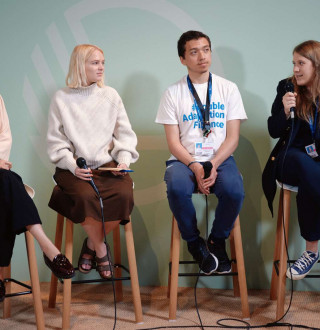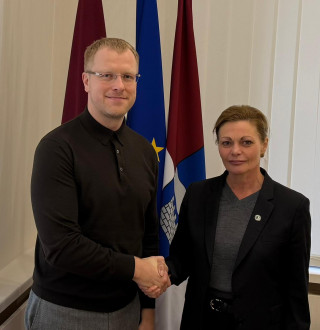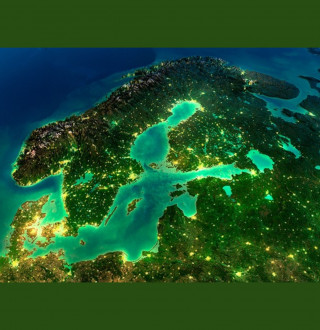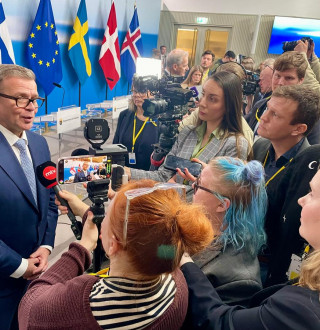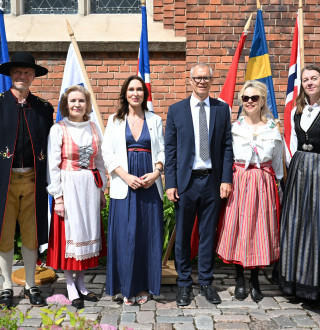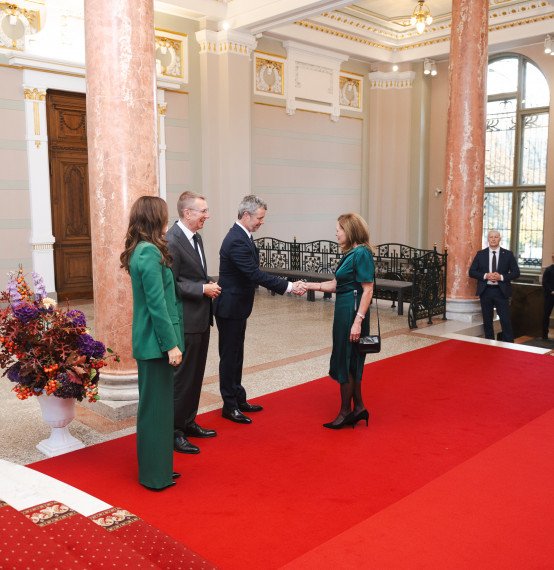A hybrid webinar held on 31 May at the Nordic Council of Ministers’ Office intended as a launching point for Nordic-Baltic discussions and a coherent action plan on national food security and individual resilience has concluded successfully. The event brought together six expert speakers: Arne Bardalen from Norway, Bettina Rudloff from Germany, Essi Kulju from Finland, Lena Maria Nilsson from Sweden, and two speakers from Latvia – Alda Nikodemusa and Maija Kāle.
Addressing the issue of national and individual preparedness for crises and potential threats related to food security, the speakers outlined different aspects and offered a glimpse into the national approach taken by their represented countries. Due to geopolitical instability, the topic of food security has once again gained the focus of policy makers. This renewed focus stems from recent developments, including the post-Covid and geopolitical situation in the region, climate change, and disruptions in supply chains affected by globalisation.
Food security is a cross-sectoral challenge, covering aspects such as food production, availability of food in terms of supply and in terms of price, land availability and use, trade, strategic planning, and the cultural habits of different societal groups. This webinar gained a lot of attention by policy makers, municipalities, researchers, and other related professionals in the field of civil defense and resilience; however, the issue of food security and resilience is relevant to everyone, from individuals and households to businesses.
Main takeaways from the presentations
Bettina Rudloff, Senior Associate at the German Institute for International and Security Affairs, spoke about new trends and policy solutions for food security risks. She introduced the concept of food security and its various aspects, both spatial and regulatory. Bettina highlighted and explained six key dimensions of food security: 1) Availability (own production, imports, and food aid); 2) Accessibility (physical, social, and economic access); 3) Utilization (interaction with other resources like water and sanitation); 4) Stability (resilience of societies to shocks); 5) Agency (political decision-making processes); 6) Sustainability (long-term food security).
Bettina outlined recent European regulations on critical infrastructures, emphasising the responsibility of private companies to help ensure food reserves. She also mentioned Germany’s national security strategy, adopted in 2023, which focuses mainly on domestic food security.
As solutions for weak food security in the region, Bettina suggested monitoring and, if necessary, increasing imports, supporting local producers, and creating a new platform for sharing and compiling experiences.
Alda Nikodemusa, Head of the Secretariat for the VASAB (Vision and Strategies around the Baltic Sea) spatial planning initiative in Latvia, discussed the vision 2040 of VASAB for the Baltic Sea region. This vision, developed working closely with numerous stakeholders, including NGOs, focuses on four main areas encompassing all VASAB activity areas:
- PEARLS: Cities, towns, and smaller administrative units.
- STRINGS: Physical and virtual connectivity.
- PATCHES: Sustainable management of shared resources, balancing natural resources with human activities, including green areas suitable for agriculture and food production in the region.
- SYSTEM: Systems, referring to multi-level governance.
In her presentation, Alda particularly focused on the third category, PATCHES. The 2040 vision outlines recommended actions to ensure food supply in the Baltic Sea region. These actions include:
- Establishing eco-village kitchens to promote cooking with local products and sustainable energy and water consumption.
- Adapting regional agriculture to climate change by cultivating new crops and vegetables.
- Strengthening local production and supply chains, as they are shorter and less vulnerable to geopolitical disruptions.
Maija Kāle, Advisor on Sustainability and Digitalization at the Nordic Council of Ministers’ Office in Latvia, discussed the role of urban agriculture in food security, emphasising the following aspects:
- Urban sustainability – increases biodiversity, provides habitat for wildlife, enhances water infiltration, and helps regulate noise and temperature in cities.
- Food security – offers additional income opportunities for low-income households, stimulates economic activity, and creates jobs in related sectors.
- Social engagement and well-being – strengthen social bonds, improves physical and mental health, enhances safety and living conditions, promotes interaction, and provides recreational opportunities.
She highlighted the notion that the more integrated and socially active a society is, united by shared values, the safer we will live. In her speech Maija referred to the research “The Future of Urban Agriculture” (attached in the section ADDITIONAL READING at the end of this article) conducted in collaboration with Nordic research organisations Nordregio and NordForsk. The report summarised common challenges and opportunities for using urban and suburban areas in the region.
Urban agriculture directly contributes to food resilience by producing food locally, shortening supply chains, using resources more efficiently (e.g., hydroponics and aquaponics), and adapting to climate change. Maija explained a four-dimensional model involving old vs. new technology and business-driven vs. community-driven action, describing the outcomes of different combinations of these dimensions.
In response to a question whether promoting urban agriculture would harm farmers, Maija explained that the biggest threat to food security is long supply chains, i.e., cross-border trade. In the near future urban agriculture is unlikely to produce such volumes of food to significantly impact the profit of farmers. Current urban food production facilities are mostly experimental with relatively low production capacity. Urban agriculture does not pose a predictable threat to farmers; instead, it will likely promote local products and encourage choosing products that have not travelled far.
Arne Bardalen, Special Advisor at the Norwegian Institute of Bioeconomy Research, focused on food security in today’s complex political climate and highlighted the need to protect agricultural land using examples from Norway. He also addressed the challenges faced by Norway and the planned actions by the government.
He referred to the following three pillars of food security:
- Stable and resilient domestic food production.
- Protection of productive soils and genetic resources.
- Well-functioning international trade and logistics.
Norway exports 42 million meals of seafood daily, but 92% of the feed used in aquaculture is imported. The most significant potential threats are geopolitical instability and climate change. Therefore, the government’s latest strategy aims for 40–50% national food self-sufficiency. This is a challenging goal since only a small portion of Norway’s land is suitable for agriculture. Of this, only 3% is arable land, and just 1% is suitable for growing cereals and other edibles.
In his address, Arne also emphasised the importance of urban agriculture, outlined the responsibilities of municipalities, and underscored the critical role of cooperation with the Baltic states, particularly in ensuring national food security.
Essi Kulju, Preparedness Specialist at the Finnish National Rescue Association (SPEK), shared insights into Finland’s recommendations for individuals to survive independently for at least three days in crisis situations. These recommendations are developed in close collaboration between government institutions and competent non-governmental organisations. They outline advisable action in various crisis scenarios, such as obstruction of public services, prolonged power outages, scarcity of drinking water, hindered telecommunication services, action in the event of a cyber-attack, and steps for building psychological resilience.
The recommendations issued by Finnish government institutions for the first 72 hours after an emergency situation do not specify particular food items that should be stored at home. Instead, they recommend building reserves from food items consumed daily. This approach has several benefits: food items remain in regular circulation, reducing waste; familiar diets during crises can alleviate emotional stress. It is advisable to choose easily prepared or non-perishable food items.
Every other year, SPEK conducts a study on individual preparedness of citizens to launch timely informational campaigns, if needed. The latest study concluded that while individual preparedness levels are improving, the overall readiness in the country remains average and needs improvement. The designated website also contains a brief test where everyone can test their preparedness for potential emergency situations. The test is available here.
Lena Maria Nilsson, Specialist in Nutritional Epidemiology and Research Project Coordinator at the Arctic Centre and the Department of Epidemiology and Global Health at Umeå University in Sweden, discussed the food security challenges faced by the Sámi population in northern Sweden. She highlighted the significant changes in food supply over the past 75 years. One of the most concerning aspects of food security in this remote region is the increase in the trade and import of food products. In earlier times, the Sámi community was more self-sufficient, but increased trade has made it more dependent and thus less protected.
Lena also examined food security from an economic and nutritional standpoint, focusing on food market value. She presented a table illustrating the nutritional differences between wild-caught and farmed salmon. In the context of food security and necessary quantities, she discussed the quality of other food products in terms of nutritional value, which is important not only in remote regions of Sweden but everywhere, also in Latvia. Lena explained this with an example of how much meat needs to be consumed to obtain the necessary amount of vitamin B12 for bodily functions. She also introduced dietary recommendations for elderly Sámi individuals, designed to facilitate the incorporation of healthy lifestyle habits into their daily lives.
The seminar shed light on various critical aspects, including the importance of shorter food supply chains, ensuring national and individual food reserves, monitoring prices, maintaining water and agricultural land quality, and securing spaces for storing food reserves. It also touched upon protectionism as a potential consequence of shorter supply chains and underscored the necessity of a food strategy where nutritional value takes precedence over the quantity of specific food products.
While the seminar has concluded, all speakers remain available for further inquiries. Should you have any questions for them, you are welcome to reach out to us by e-mailing Maija Kāle at maija.kale@norden.lv, and we’ll make sure your inquiry is forwarded.
As the moderator Torfi Johannesson reminded in the closing remarks, the seminar serves as a starting point for fostering closer, practical cooperation among industry professionals in Latvia and the Nordic countries. To achieve this goal, we encourage active participation in future thematic events, providing opportunities to engage with fellow participants and forge new networks of collaboration and potential partnerships.
The seminar was initiated by the EU Strategy for the Baltic Sea Region (EUSBSR), PA-Bioeconomy, PA-Secure, and hosted by the Nordic Council of Ministers’ Office in Latvia. The event was attended by over 100 people in person or online.
ADDITIONAL READING
European Food Security Crisis preparedness and response Mechanism (EFSCM)
Nordic Perspectives on Transboundary Climate Risk: Current knowledge and pathways for action
